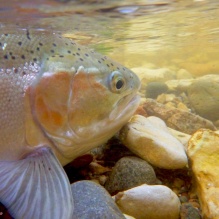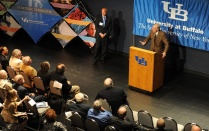Krabbenhoft co-curates the Fish and Climate Change Database (FiCli)

“The Fish and Climate Change Database pulls information together in a way that people can meaningfully use it,” says Trevor Krabbenhoft. “The idea is not just to document how fish have been affected by climate change, but to also provide information on management options that can help mitigate some of those effects.” Researchers, fisheries managers, conservationists, journalists and others can use FiCli to find scientific articles based on factors such as fish species, habitat type, location and type of climate change impact (such as a change in temperature or precipitation). Read the full article by Charlotte Hsu.
The American Fisheries Society funded workshops that led to the FiCli database, with in-kind support from the USGS National Climate Adaptation Science Center and the Missouri Cooperative Fish and Wildlife Research Unit.
Research News
New database tracks climate change’s toll on freshwater fish

The rainbow trout (Oncorhynchus mykiss). Image: Nick Jones/Ontario Ministry of Natural Resources and Forestry
By CHARLOTTE HSU
Published April 28, 2020 This content is archived.
Scientists have created a new database to help track the impacts of climate change on fish living in rivers, lakes and other inland waters throughout the world.
The Fish and Climate Change Database — or FiCli (pronounced “fick-lee”) — is a searchable directory of peer-reviewed journal publications that describe projected or documented effects of climate change on inland fishes.
These wild animals are a vital source of food and income for many people, and an indicator of the health of global aquatic ecosystems. A better understanding of how climate change is affecting these fishes could aid in their future survival, informing conservation efforts.
The FiCli team published a detailed description of the database on April 21 in Scientific Data, an open-access journal. The project was led by Trevor Krabbenhoft, a fish biologist at UB, and Bonnie Myers, a fish biologist at the U.S. Geological Survey (USGS) and PhD candidate at North Carolina State University.
“The Fish and Climate Change Database pulls information together in a way that people can meaningfully use it,” says Krabbenhoft, assistant professor of biological sciences, College of Arts and Sciences, and the RENEW (Research and Education in eNergy, Environment and Water) Institute. “The idea is not just to document how fish have been affected by climate change, but to also provide information on management options that can help mitigate some of those effects.”
Researchers, fisheries managers, conservationists, journalists and others can use FiCli to find scientific articles based on factors such as fish species, habitat type, location and type of climate change impact (such as a change in temperature or precipitation).
FiCli search results include journal article titles, instructions for accessing publications and brief summaries of such information as how fish populations have responded to climate change and what management actions are recommended.
According to the paper in Scientific Data, FiCli “currently includes information for 53 freshwater fish families, 232 studies from more than 47 countries, and 851 projected and 377 documented responses of individual species or assemblages to climate change.”
Curators including Krabbenhoft, Myers and Abigail Lynch, a research fish biologist at the USGS National Climate Adaptation Science Center, will update the database as new studies are published. Users can also contact the team about peer-reviewed papers that are missing from the database and may be a good fit.
“The FiCli project grew, in a way, out of our need for a database as scientists,” Krabbenhoft says. “We were trying to understand how climate affects fish, and we had a really hard time identifying the right papers. By synthesizing the available information on how climate change has already affected fish populations, it helps us refine our predictions for how fish are likely to be affected in the future. Hopefully we’ve created something that will be meaningful for other fishery biologists.”
“As researchers, we often try to avoid ‘reinventing the wheel’ to save valuable time and resources. Compiling and synthesizing published scientific results is an important step in any research project. We hope FiCli serves as a time-saving, informative database that helps advance scientific understanding and management of the impacts of climate change on important aquatic resources and guides future climate adaptation efforts," says Myers, a research fish biologist at the USGS National Climate Adaptation Science Center and PhD candidate in the North Carolina State University Department of Applied Ecology and the North Carolina Cooperative Fish and Wildlife Research Unit, which is housed at the university.
In addition to Krabbenhoft, Myers and Lynch, co-authors of the Scientific Data paper included Jesse P. Wong of George Mason University; Cindy Chu of the Ontario Ministry of Natural Resources and Forestry; Ralph W. Tingley III of the Missouri Cooperative Fish and Wildlife Research Unit housed at the University of Missouri; Jeffrey A. Falke of the Alaska Cooperative Fish and Wildlife Research Unit housed at the University of Alaska Fairbanks; Thomas J. Kwak of the North Carolina Cooperative Fish and Wildlife Research Unit housed at North Carolina State University; and Craig P. Paukert of the Missouri Cooperative Fish and Wildlife Research Unit.
The American Fisheries Society funded workshops that led to the FiCli database, with in-kind support from the USGS National Climate Adaptation Science Center and the Missouri Cooperative Fish and Wildlife Research Unit.
Faculty Profile

Trevor J. Krabbenhoft
PhD
Research Interests
Fish evolution and ecology; genome evolution; climate change.
Education
PhD, Biology, University of New Mexico
Office Hours
Research Summary
Research is focused on how fish respond to environmental change, including climate change, non-native species, contaminants, and overfishing. A central aim is to understand what fish can tell us about aquatic ecosystem health and help us key-in on emerging issues.
The Krabbenhoft Lab studies the ecology of fish in a changing world. Research in the Krabbenhoft Lab is focused on how fish respond to environmental change, including climate change, invasive species, contaminants, and fishing pressure. We rely heavily on functional genomics and bioinformatics to test hypotheses related to mechanisms underlying how fish respond to their environment. By focusing on mechanisms, we can better predict outcomes for future scenarios of environmental change.
This research has important management and conservation implications both locally for Great Lakes and more broadly for aquatic ecosystems worldwide.
Examples of ongoing projects in the Krabbenhoft Lab include:
(1) The development of RNAseq-based methods for studying the trophic ecology of organisms. We are exploring how high-throughput DNA sequencing can be used to complement more traditional methods of studying energy flow in ecosystems – such as stomach contents and analysis of stable isotopes from tissue samples. Ultimately, our goal is to more thoroughly integrate evolution and genomics with ecology.
(2) Studies of sex determination and gene silencing in allopolyploid catostomid fishes. Along with colleagues, we are using restriction-site associated DNA sequencing (RADseq) and long read genome sequencing to understand mechanisms of sex determination in catostomid fishes. For example, what is the relative contribution of environmental versus genetic variation in determining sex in catostomids? We are also interested in evolutionary processes shaping genome evolution following whole genome duplication in this group of fishes. For example, are patterns of gene silencing random with respect to gene function, or are some types of genes preferentially retained or lost?
(3) Genomic mechanisms underlying phenotypic diversity and adaptation in coregonid fishes in the Great Lakes. We are using long read genome sequencing and sequence capture to identify genetic changes driving the extensive morphological and ecological diversity in a species flock in the genus Coregonus. We are focusing on protein coding regions and non-coding regulatory regions to understand how natural selection and other evolutionary forces shape the genomes of these fishes. Our hypothesis is that genetic variants most strongly associated with phenotypic forms should be related to the functional pathways that give rise to that variation. In a broad sense, this research aims to help us understand proximate forces that generate and maintain biodiversity.
(4) Global- and regional-scale studies of climate effects on inland fish and fisheries. We are also involved in collaborative efforts to understand how climate change is affecting fish and fisheries around the world. To date, climate change has been shown to affect fish in five general categories: (1) distribution, (2) phenology, (3) demographics, (4) evolution, and (5) assemblage dynamics. We are working to find novel ways to document and understand previous climate effects on fishes and refine our predictions for future responses to ongoing climate change.
(4) Global- and regional-scale studies of climate effects on inland fish and fisheries. We are also involved in collaborative efforts to understand how climate change is affecting fish and fisheries around the world. To date, climate change has been shown to affect fish in five general categories: (1) distribution, (2) phenology, (3) demographics, (4) evolution, and (5) assemblage dynamics. We are working to find novel ways to document and understand previous climate effects on fishes and refine our predictions for future responses to ongoing climate change. The Fish and Climate Change Database is here.
Selected Publications
- Krabbenhoft TJ, Turner TF (2017) Comparative transcriptomics of cyprinid minnows and carp in a common wild setting: a resource for ecological genomics in freshwater communities. DNA Research. Online Early.
- Myers BJE, Lynch AJ, Bunnell DB, Chu C, Falke JA, Kovach R, Krabbenhoft TJ, Kwak TJ, Paukert CP (2017) *Authors 3-9 listed alphabetically. Global synthesis of the projected and documented climate change effects on inland fishes. Reviews in Fish Biology and Fisheries 27:339-361. Invited contribution for special issue: Impacts of climate change on marine and inland fishes and fisheries.
- Lynch AJ, Myers BJE, Chu C, Eby LA, Falke JA, Kovach RP, Krabbenhoft TJ, Kwak TJ, Lyons J, Paukert CP, Whitney JE (Authors 3-9 listed alphabetically) (2016) Climate change effects on North American inland fish populations and assemblages. Fisheries 41:346-361. Invited contribution for special issue on climate change effects on inland fishes. Publication led to briefings to US Congressional panel on climate change effects on inland fish.

